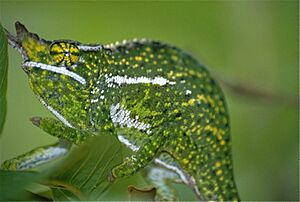Canopy chameleon facts for kids
Quick facts for kids Canopy chameleon |
|
|---|---|
 |
|
| male | |
| Conservation status | |
| Scientific classification | |
| Genus: |
Furcifer
|
| Species: |
willsii
|
 |
|
| Geographic range of Furcifer willsii | |
| Synonyms | |
|
|
The canopy chameleon (Furcifer willsii) is a type of lizard from the Chamaeleonidae family. People also call it Wills's chameleon. This amazing creature lives only in Madagascar. A scientist named Albert Günther first described this species in 1890.
Contents
What's in a Name?
Why is it Called Wills's Chameleon?
The scientific name, willsii, honors an English bird expert named Rev. James Wills. He was a missionary in Madagascar from 1870 to 1898.
Where Do Canopy Chameleons Live?
Madagascar's Forests Are Home
The canopy chameleon lives only in Madagascar. You can find it in the east-central and northeastern parts of the island. There's also a separate group in the north-central area.
High Up in the Trees
These chameleons live in forests between 600 and 1300 meters (about 2,000 to 4,300 feet) above sea level. They prefer humid forests and are often found high in the tree canopy. They can even live in areas where forests have been slightly changed by humans.
How Much Space Do They Need?
Scientists estimate that this species lives across an area of about 100,350 square kilometers (about 38,750 square miles). This is a very large area!
Are Canopy Chameleons Safe?
Their Conservation Status
The International Union for Conservation of Nature (IUCN) watches over animal populations. They think the number of canopy chameleons is going down. However, they are currently listed as "Least Concern". This means there isn't enough proof that their numbers are dropping fast enough to be in danger yet.
What Threats Do They Face?
The biggest threats to the canopy chameleon are farming and logging. These activities clear away the forests where they live. Many of these chameleons were also exported from Madagascar between 1989 and 1993. After that, a treaty called CITES banned their trade from Madagascar.
What Do Canopy Chameleons Look Like?
Colors of the Canopy Chameleon
The Furcifer willsii is mostly green and white. Sometimes, you might see a little bit of brown along its back and head.
How Do They Have Babies?
Laying Eggs
F. willsii is an oviparous species. This means that the female chameleon lays eggs, and the baby chameleons hatch from these eggs.
How Scientists Classify Them
A Brief History of Their Name
The canopy chameleon was first described in 1890. Albert Günther named it Chamaeleon willsii back then. Later, in 1986, two scientists, Charles Klaver and Wolfgang Böhme, moved it to the Furcifer group of chameleons.


